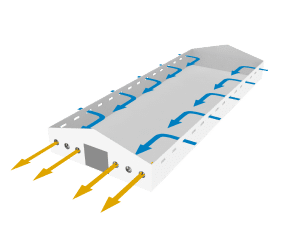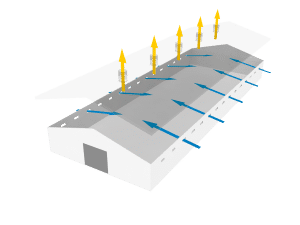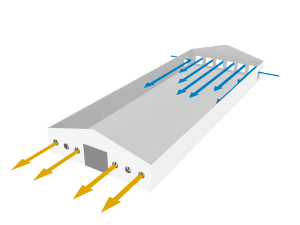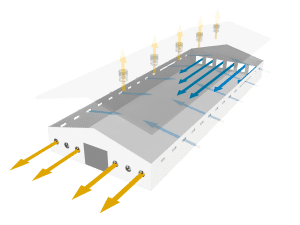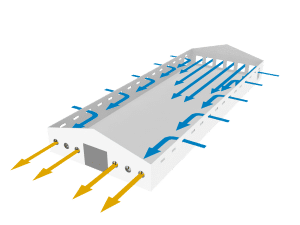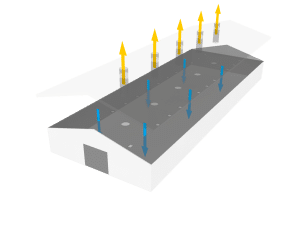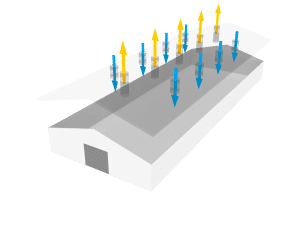Ventilatieconcepten voor Veehouderij
Cross Ventilation
Cross ventilation is ideal for houses that have either doors, maintenance or processing rooms on the gable sides. In a cross ventilation set-up air inlet valves are installed in the sidewall. In the opposite sidewall fans take out the air after it has crossed the width of the building hence the name. This type of ventilation is especially suitable for narrow houses. For poultry houses that require some form of cooling but where tunnel ventilation is no option, cross ventilation is the ideal solution.
longitudinal Ventilation
Longitudinal ventilation is mostly used in wider houses. It is also suitable for houses with obstacles such as aviaries, pens, cages, walkways, boarding and such. The basic principle is that air is taken in through air inlet vents alongside both sidewalls of the building. The exhaust of dirty air in this concept is done with big fans in the end gable wall. These fans are built with a cascade control to gradually increase the capacity as animals grow bigger or as the temperature rises.
We see this type of ventilation all over the world as it is one of the most popular kinds of ventilation. This concept works for almost all types of animals.
Roof Ventilation
Roof ventilation makes use of air inlet valves in both side walls to take air into the house. Exhaust chimneys on the roof take out the dirty air. This method of ventilation is used for example when exhaust fans in the end gables are not an option. This is a very common concept we often see in use worldwide, in both poultry houses and pig farms.
This concept is easily usable in poultry houses located in intermediate climate zones. For pigs this concept also works well when air inlets with straight inner valves are used. Straight inner valves help guide the air upwards to the ceiling thus preventing cold air from dropping onto the animals to early. In combination with a heating system for winter and a spray cooling (or fogging) system for summer, this concept works well for most houses.
Tunnel Ventilation
Tunnel ventilation is mostly used in combination with other ventilation concepts. This concept is perfect for cooling birds during hot summer days or when approaching max weight. A combination of this ventilation concept with cooling pads in particular is a great way to cool birds.
For pigs this type of ventilation is not desirable but sometimes needed. Pigs do not have fur or any type of protective coat therefore they are much more sensitive for draft. When it gets really hot we sometimes see farmers having no other option but to use some tunnel ventilation.
Combined Roof – Tunnel Ventilation
This is a combination of two concepts. During minimum ventilation (or low temperatures) the air enters through air inlet valves in both sidewalls. Exhaust air is taken out of the house via exhaust chimneys. During maximum ventilation, the tunnel units are opened and the airspeed increases in order to cool the animals. Big exhaust fans in the end gable take the air out.
This concept is very useful for keeping birds as it offers a lot of control over a wide range of temperatures and climate conditions. During cold periods the chimneys make sure there is no draft over the length of the house. When there is an intermediate period both sidewall inlets and gable fans can offer some cooling before the tunneling starts. During hot periods the tunnel ventilation system takes care of cooling and chimneys are completely closed.
Combined Longitudinal – Tunnel Ventilation
This is again a combination of two concepts only in this case there are no chimneys used. During the minimum ventilation phases, the air is taken in through sidewall vents. When it gets warmer or when the animals start to gain weight significantly, the tunnel ventilation starts and is gradually increased. The exhaust air is taken out of the house by fans in the end gable.
This concept is again a concept mostly seen in poultry and not so much in pig housing. For poultry, this ventilation concept is widely used in warmer climates around the world. Longitudinal ventilation already brings some airflow or draft over the length of the house and when tunnels are gradually opened they add to that effect. In combination with cooling pads, this system works well in hot weather circumstances.
Ceiling Ventilation
Ceiling ventilation uses air intake valves mounted in the ceiling between the attic and the populated part of the house. In this attic the air is pre-heated so cold air cannot drop directly onto the animals. The exhaust air is taken out of the house via the floor or gable fans. This ventilation method is very reliable in the colder parts of the world. Basically incoming air is preconditioned before reaching the animals. In many cold areas, we see this system as preferable in pig farms. For poultry, equal benefits are observed in cold areas.
Chimney Ventilation
Chimney ventilation is the perfect solution when the side walls cannot be used to place air vents. In this concept, both the intake and exhaust of air are organized through chimneys. In most houses, this concept works with negative pressure meaning only the exhaust chimneys are equipped with fans. For free-range poultry houses or houses with equal pressure concepts, chimneys are the perfect solution. In the equal pressure set-up, both intake and exhaust chimneys are equipped with fans to actively push clean air in and pull dirty air out.
Chimneys give the opportunity to create a balanced spread of fresh air that reaches all corners of the house. Chimneys are therefore favorable in very wide houses with cages or aviaries. For pig housing, the intake chimneys should be recirculation chimneys as the help to pre-condition the incomming air. By mixing warm air from inside the house with fresh outside air you can ensure no cold air drop falls directly onto the animals.


